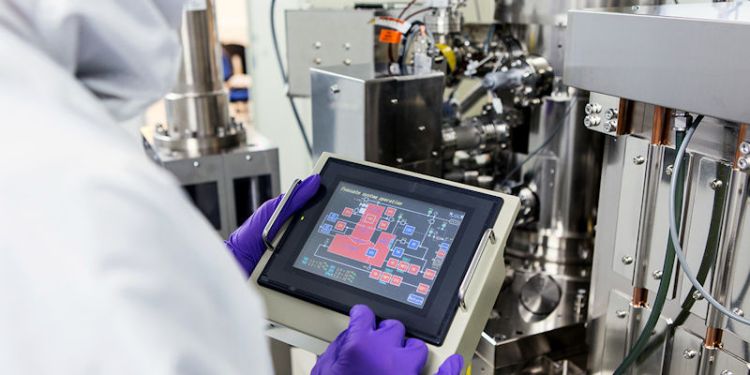Terahertz electronics and photonics
Our research

Terahertz (THz) frequencies (300GHz–10THz) span the gap in the electromagnetic spectrum between the millimetre/microwave electronic technologies used at lower frequencies and the mid-infrared optic/optoelectronic techniques employed at higher frequencies.
Our researchers are playing a pivotal role in developing THz science and technology, which is becoming a vibrant international research area. For example, we are:
- Growing (by molecular beam epitaxy), fabricating and optimizing THz quantum cascade lasers (QCLs). These compact solid-state, semiconductor sources contain over 1000 individual semiconductor layers, each patterned to atomic layer resolution.
- Designing an apparatus for mode-locking THz QCLs, probing laser dynamics, and obtaining precise control of the emission frequency. This underpins future applications in non-linear THz science and satellite instrumentation for Earth observation and planetary exploration.
- Designing state-of-the-art THz imaging and spectroscopy systems. This includes pioneering work on self-mixing, where a laser acts as both source and detector, providing compact instrumentation and phase-sensitive detection.
- Integrating THz radiation with on-chip waveguides and filters, to probe low-dimensional semiconductor nanostructures on picosecond timescales, and underpin future generations of high-frequency electronic devices and circuits.
- Investigating imaging and spectroscopy applications, ranging from the study of semiconductor, magnetic, and plasmonic materials, through to pharmaceuticals, drugs-of-abuse, explosives, and biological systems, such as proteins.
Research highlights
- Demonstration of world record THz QCL powers, and the first use of photonic crystal structures, graded photonic heterostructures, and ‘spoof’ surface plasmons to engineer emission profiles.
- The first demonstration of a THz pulse amplifier, and active mode-locking of a THz QCL, leading to the first measurement of sampling coherence in a QCL.
- Investigation of universal conductivity scaling in the high-frequency quantum Hall regime, and the first picosecond probing of THz plasmons in coupled two-dimensional semiconductor resonators.
- First comparison of quantum mechanical and classical simulations of THz spectra, focusing on explosives, and the first spectroscopy of functional single-crystal proteins under physiological conditions.
- The first demonstration of new THz QCL imaging/spectroscopy methodologies, including self-mixing imaging, and the first waveguide-integrated THz QCL technology for in-orbit satellite demonstration of Earth observation.
Collaborations and partnerships
The Terahertz Electronics and Photonics group has received extensive funding from the EPSRC, NERC, European Community, European Space Agency and the UK’s Centre for Earth Observation, together with end-users including the UK’s Centre for Applied Science and Technology and the US Defence Threat Reduction Agency.
The group is currently part of an EPSRC Programme grant (EP/J017671/1, with UCL, Cambridge and the London Centre for Nanotechnology), a partner in a Horizon 2020 FET-Open programme (ULTRAQCL), and leads the EPSRC TERANET (EP/M00306X/1) network of researchers in THz science and technology, as well as receiving funding from the European Space Agency.
The group works closely with a broad range of international collaborators, including the Universities of Harvard, Texas, Nanyang Technological, Shanghai Institute of Technical Physics, Queensland, Bochum, Paris Sud, Paris 7, and École Normale Supérieure, as well as governmental research laboratories such as the National Physical Laboratory, and the Rutherford Appleton Laboratory.
Further information
View all members of our research group and publications.
PhD projects
We have opportunities for prospective postgraduate researchers. Find out more.
Contact us
If you would like to discuss an area of research in more detail, please contact a relevant member of the research team.

